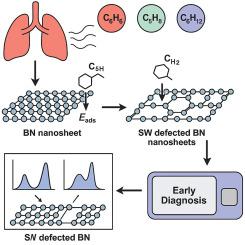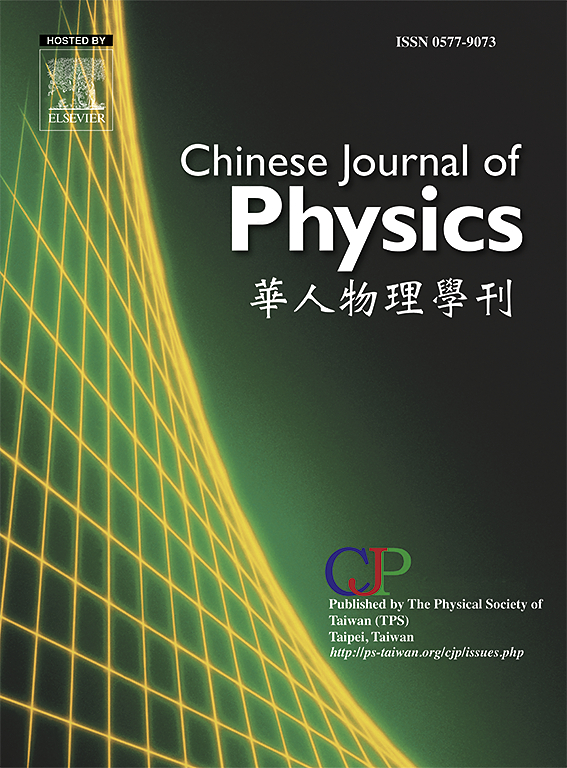Adsorption properties and sensing capabilities of pristine and Stone–Wales defected BN nanosheets for lung cancer VOC biomarkers: A DFT investigation
IF 4.6
2区 物理与天体物理
Q1 PHYSICS, MULTIDISCIPLINARY
引用次数: 0
Abstract
Lung cancer (LC) continues to be a predominant cause of global mortality, with early identification being a significant challenge due to the constraints of existing detection technologies, which are frequently invasive, expensive, and inaccessible. This study utilized density functional theory (DFT) to systematically examine the efficacy of both pristine and Stone–Wales (SW) defect-engineered BN nanosheets as selective biosensors for the early detection of LC-associated volatile organic compounds (VOCs): benzene (C₆H₆), isoprene (C₅H₈), and methyl-cyclopentane (C₆H₁₂). Thorough simulations demonstrated that the incorporation of software faults markedly modifies the electrical structure of BN nanosheets, thereby improving their sensitivity and selectivity for the target VOCs. The adsorption energy estimates (Eads) were consistently negative across all systems, signifying stable and exothermic interactions. The adsorption energies of benzene, isoprene, and methyl-cyclopentane on virgin BN were −0.787 eV, −0.893 eV, and −0.740 eV, respectively; for the BN-SW substrate, the values were −0.770 eV, −0.839 eV, and −0.603 eV, respectively. These findings validate the thermodynamic favorability and strong interaction between the VOCs and the sensor surfaces. The computed global reactivity descriptors and recovery durations further substantiate the efficacy of BN and BN-SW nanosheets for real-time biosensing. This study illustrates that both pristine and defect-engineered BN nanosheets, especially those with Stone–Wales defects, present highly promising platforms for the early detection of lung cancer biomarkers, facilitating the future creation of efficient, non-invasive diagnostic devices.

原始和Stone-Wales缺陷BN纳米片对肺癌VOC生物标志物的吸附特性和传感能力:一项DFT研究
肺癌(LC)仍然是全球死亡的主要原因,由于现有检测技术的限制,早期识别是一项重大挑战,这些技术通常是侵入性的,昂贵的,并且难以获得。本研究利用密度泛函理论(DFT)系统地检查了原始和石威尔士(SW)缺陷工程的BN纳米片作为选择性生物传感器的功效,用于早期检测与gc相关的挥发性有机化合物(VOCs):苯(C₆H₆)、异戊二烯(C₅H₈)和甲基环戊烷(C₆H₁₂)。全面的模拟表明,软件故障的加入显著改变了BN纳米片的电结构,从而提高了它们对目标voc的灵敏度和选择性。所有系统的吸附能估价值(Eads)均为负,表明稳定的放热相互作用。苯、异戊二烯和甲基环戊烷在原生BN上的吸附能分别为- 0.787 eV、- 0.893 eV和- 0.740 eV;BN-SW衬底的值分别为- 0.770 eV、- 0.839 eV和- 0.603 eV。这些发现验证了VOCs与传感器表面之间的热力学优势和强相互作用。计算的全局反应性描述符和恢复持续时间进一步证实了BN和BN- sw纳米片在实时生物传感方面的功效。这项研究表明,无论是原始的还是缺陷工程的BN纳米片,特别是那些具有Stone-Wales缺陷的纳米片,都为肺癌生物标志物的早期检测提供了非常有前途的平台,促进了未来高效、非侵入性诊断设备的创造。
本文章由计算机程序翻译,如有差异,请以英文原文为准。
求助全文
约1分钟内获得全文
求助全文
来源期刊

Chinese Journal of Physics
物理-物理:综合
CiteScore
8.50
自引率
10.00%
发文量
361
审稿时长
44 days
期刊介绍:
The Chinese Journal of Physics publishes important advances in various branches in physics, including statistical and biophysical physics, condensed matter physics, atomic/molecular physics, optics, particle physics and nuclear physics.
The editors welcome manuscripts on:
-General Physics: Statistical and Quantum Mechanics, etc.-
Gravitation and Astrophysics-
Elementary Particles and Fields-
Nuclear Physics-
Atomic, Molecular, and Optical Physics-
Quantum Information and Quantum Computation-
Fluid Dynamics, Nonlinear Dynamics, Chaos, and Complex Networks-
Plasma and Beam Physics-
Condensed Matter: Structure, etc.-
Condensed Matter: Electronic Properties, etc.-
Polymer, Soft Matter, Biological, and Interdisciplinary Physics.
CJP publishes regular research papers, feature articles and review papers.
 求助内容:
求助内容: 应助结果提醒方式:
应助结果提醒方式:


